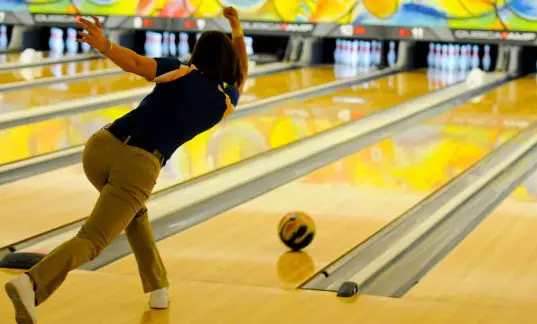Proximity plays a huge role in bowlers’ alleys of choice, dictating for them what type of lane conditions they’re going to predominantly be playing with. If your bowling alley(s) of choice have lanes with medium to dry oil density, you’re going to need a bowling ball for medium to dry lanes which can maximize those conditions and the positive effect they have on your overall shot.
Finding the right bowling ball has a lot to do with what type of lanes you’re mainly playing on, making it crucial that you do your research if you’re frequenting establishments which favor a medium to dry oil setup on their lanes. What type of bowling ball do you need? What are the key factors to consider when finding a bowling ball for medium to dry lanes, comparatively to those which function better with heavy oil patterns?
Let’s dive deep and help you find the perfect bowling ball for use on medium to dry lanes.
Bowling Ball Buyers Guide For Medium To Dry Lanes
To find the best bowling ball for medium to dry lanes, it’s largely about the finish and the stiffness of your bowling ball cover stock. A stiffer, less porous polyurethane cover stock or a hard plastic cover stock keeps your ball from expending too much energy early after release. It allows your ball to carry down the lane with less of an initial need for reacting to oil density.
This promotes a much more consistent and even lane length which allows your ball to save the energy generated by speed and revolutions for a violent impact with the pin pocket.
A hard pearl cover stock well-finished to a shiny overall presentation is an ideal tool to have on medium to dry lanes. In addition, a bowling ball with a symmetric core will help you maintain control when a dry lanes gets dicey and your ball needs stabilization.
Some asymmetric cores will still work well, though. It all depends on your overall hook shot, but just know that your hook may have to sacrifice some of the sharpness you’d get on a heavy oil lane in favor of a more controlled, more geometrically sound hook pattern.
6 Of The Best Bowling Balls For Medium To Dry Lanes
1. DV8 Alley Cat Bowling Ball
No products found.
The DV8 Alley Cat is one of the smoothest budget bowling balls out there, giving you a cost-effective gem to discover when it comes to bowling on medium to dry lanes. The pearl reactive cover stock gives you a predictable lane carry and initial glide, while the symmetrical core is perfectly balanced for making that predictability count in pin carry.
Pros:
- Fantastic price point for the quality you’re getting.
- Made with dry and medium lanes in mind, from the cover stock on in.
- A perfect pick-up-and-play ball for bowlers of all different skill levels, reacts consistently to keep beginning bowlers on the lane and making shots
Cons:
- Only portends moderate hook potential regardless of lane oil conditions.
- If the lane oil conditions are more medium-heavy than truly medium, you might get frustrated with a deadened initial reaction.
2. Hammer Blue Vibe Bowling Ball
No products found.
Combining initial lane carry predictability with Hammer’s signature pin hitting power and violence, the revival of the Hammer Blue Vibe bowling ball has led bowlers of all different skill levels to rejoice. It’s simply one of the best dry lane bowling balls you can get at any price point, let alone at the very reasonable price it’s currently selling at.
Pros:
- Trademark Vibe symmetrical core displaces energy evenly and helps store energy for a massive pin reaction burst at the back end of your shot.
- CT Reactive Plus solid reactive cover stock is extremely durable and gives you some solid late hook potential when thrown with efficacy.
- Priced extremely fairly, especially with its high-performance output.
Cons:
- Unlike the other balls on this list, this ball skews much more in favor of dry lanes than both dry and medium lanes. It can be a little weak in reacting to medium oil patterns, so be warned.
- It’s not a true revival of the Hammer Blue Vibe with some tinkering done. So, it’s not going to react the same way you remember if you played with the original.
3. Ebonite Destiny Hybrid Bowling Ball
No products found.
The Ebonite Destiny Hybrid bowling ball was specifically engineered with medium to dry lanes in mind, finished perfectly with its Powerhouse Factory Finish Polish to ensure your ball stays consistent early in its lane carry and saves up energy for a final back-end reaction melee. It combines the best of solid and pearl cover stock reactivity for a unique, consistent overall performance.
Pros:
- Priced nicely for budget-conscious bowlers without sacrificing all of the key bells and whistles of a high-performance bowling ball.
- The ball’s Cyclone Torque shaping is perfectly calibrated to suit both high-rev bowlers and beginning bowlers who won’t be tapping into its high RG and high differential right off the bat.
- Provides fantastic lane length on both dry lanes and medium lanes, while also providing sneaky strong hook potential.
Cons:
- If you happen to play on a lane that has a heavy oil pattern, the Ebonite Destiny Hybrid may tend to skid and lose its efficacy.
- Can be a little wild and hard to tame dfor intermediate bowlers who are testing out their hook potential on medium-oiled lanes.
4. Storm Fever Pitch Bowling Ball
No products found.
While the Storm Fever Pitch bowling ball technically has a urethane cover stock, it still reacts late with the power and snap of the best high-performance reactive resin bowling balls out there. It’s a urethane bowling ball for those who have been skeptical of urethane bowling balls before, giving you the right combination of lane carry and hook potential while also proving extremely durable.
Pros:
- The Pwr + Ctrl cover stock lives up to its billing. It conserves power fantastically early in your lane carry, holding your line before expending its energy with a violent flash when it hits the pins.
- Its 2000 grit Abarlon factory finish dials down the aggression in favor of lane carry and consistency – perfect for both dry and medium oil lanes.
- The symmetrical weight block heightens your control and the overall smoothness of your shot.
Cons:
- Urethane traditionalists may balk and consider this to be more of a reactive resin ball. It’s not going to give you what you normally expect out of a urethane ball.
- It sacrifices initial reactivity for staying power, which makes it a struggle if the lanes lean more towards medium-heavy oil density than medium.
5. Roto Grip MVP Bowling Ball
No products found.
The Roto Grip MVP bowling ball was built for those who want a strong back-end reaction rather than a ball which begins its reaction too early and too strongly. If there is a transition in oil density on the lane you play at, this ball is perfect for utilizing shifting oil patterns to the utmost efficacy. It’s a great dry lane ball and a great medium lane ball, and a great ball when both of those oil densities present themselves on the same lane.
Pros:
- VTC-H19 Hybrid cover stock has a heightened friction response at the back of the lane, revving things up late in the shot for extremely powerful pin carry.
- The Neutron NXT core has a higher RG than its predecessors, giving you a fantastic reaction at the break point which will cause pretty effective pin trajectories upon impact.
- It’s the perfect mid-performance ball for bowlers who want the right balance of lane length and late-shot violence.
Cons:
- Taking this ball to a medium-heavy oil lane will result in some serious skidding and lack of power potential. Be forewarned.
- There is a noted sacrifice of potential hook sharpness for control, so it can be a little dead for bowlers who need an extra oomph.
6. Radical Counter Attack Pearl Bowling Ball
No products found.
The Radical Counter Attack Pearl bowling ball has the most lane length out of any of the Radical Counter Attack bowling balls. That’s perfect for dry lanes where lane length and control win out over initial reactivity and friction differential. It has a strong break point reaction which turns predictability into pin carry over and over again.
Pros:
- Rack Attack 2 Symmetric core is perfect for building energy towards a back-end reaction flourish which leads to fantastic pin violence and carry.
- Ai-20 Reactive Pearl cover stock has the right stiffness and rigidity for dry lanes and medium lanes, cutting into initial reactivity in favor of a finishing flourish.
- The perfect dry lane bowling ball which also has enough reactivity to make a medium lane work to its advantage.
Cons:
- It can be a little spotty on lanes which transition in oil density. You may have to adjust your shot a bit to help with such a transition.
- Serves as skidding dead weight if the lanes are more medium-heavy than medium.
What Do Medium To Dry Lanes Mean In Bowling?
Medium to dry lanes refers to the overall oil density on a bowling lane. Different bowling alleys prefer different levels of oil densities on their lanes, be it for protection of the lane surfaces or for the added reactivity for certain high-performance balls when more oil is added to the lanes.
A dry lane will have some oil on it, but it’s much drier in comparison to the average bowling lane. The right bowling ball will use this to its advantage, dialing down the aggression of the cover stock in favor of a ball that stays controlled and even with less oil absorbed.
A medium lane is one of average oil density. This is usually the most ideal for bowlers because it allows for both control-heavy bowlers and hook-heavy, reactivity-reliant bowlers to get what they need out of the lane conditions.
Closing Thoughts
Finding the right bowling ball for medium to dry lanes can be tricky, but our buyers’ guide has plenty of options for you to choose from to at least get your search rolling.
The right bowling ball for you is the one that’s going to turn your favorite bowling alley’s lane conditions into another tool in your bowling tool kit. While some of these bowling balls sacrifice overall reactivity for control, you’ll thank them for doing so when the lanes get dry and you need more lane length to keep things steady and scores high.

